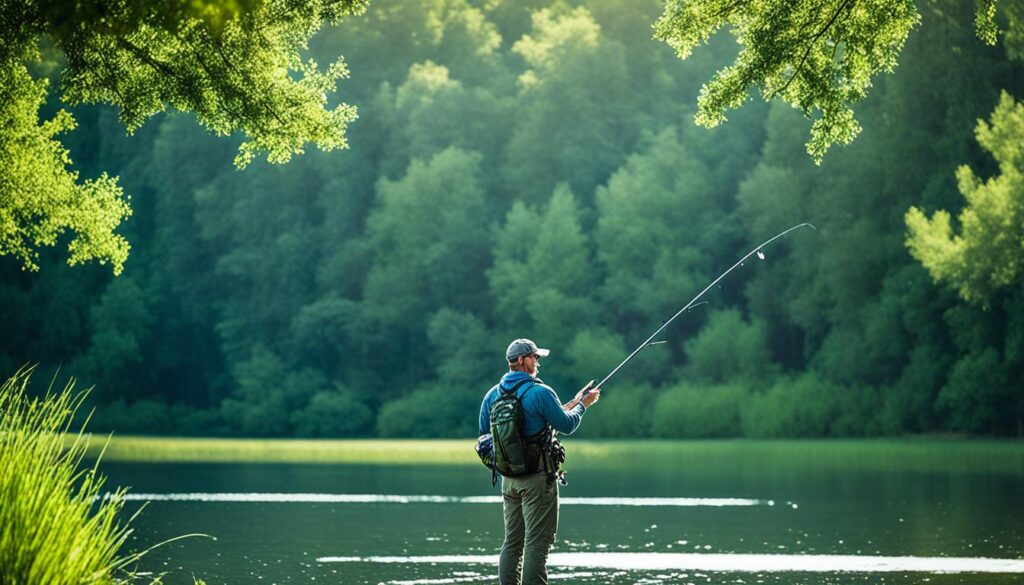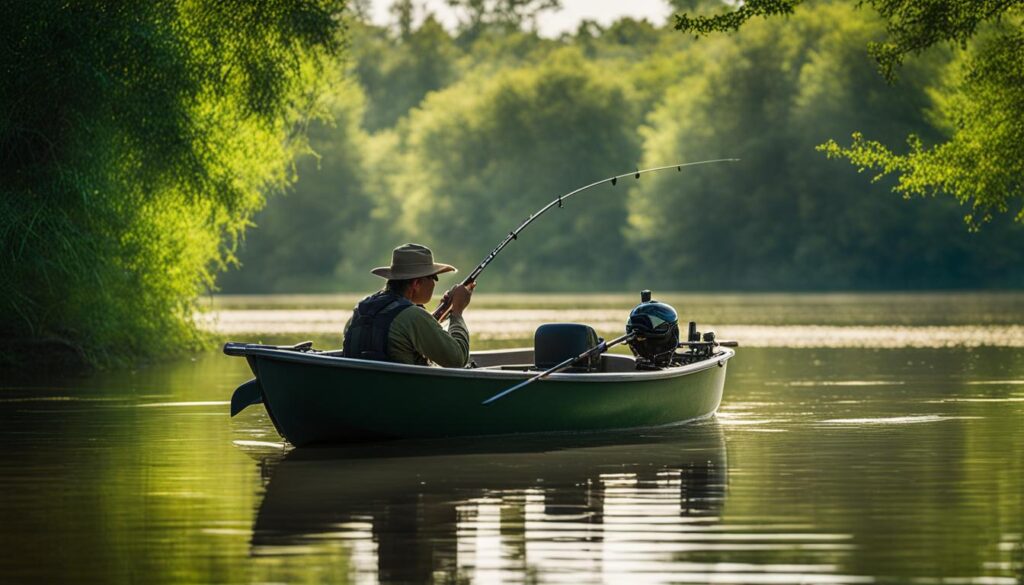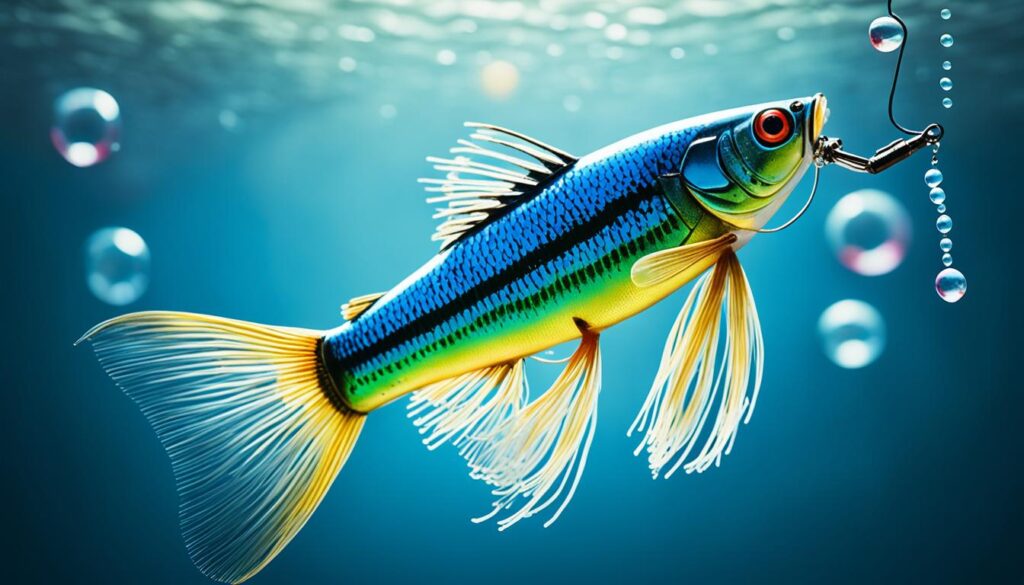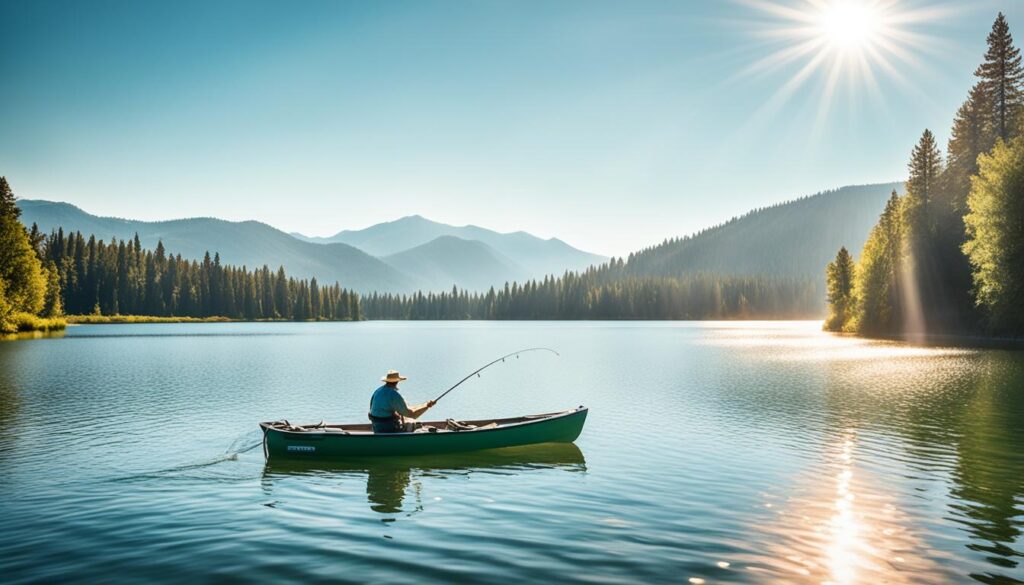Summer is here, and it’s time to hit the water for some exciting bass fishing. But fishing in hot weather can present its challenges. Fish become less active and heat-stressed, making them harder to catch. However, with a few strategic solutions, you can beat the heat and increase your chances of landing that prized bass.
As an avid angler, I’ve discovered some effective techniques and tactics to stay cool while fishing during the summer months. In this article, I will share three bass fishing solutions that will help you make the most of your time on the water. From targeting shaded areas to using the right bait for fast-moving water, these tips will give you an edge in hot weather conditions.
Angler’s Essentials
- Look for areas with fast-moving currents to find active fish in hot weather.
- Seek out shade and use spinnerbaits or buzz baits to entice fish.
- Use worms as bait and adjust your fishing speed to trigger strikes.
- Explore deep water and fish at night for better results.
- Target shallow areas near the shoreline and use bobber rigs for panfish.
Look for Current
Fish in the summer often seek out areas with fast-moving currents. These areas provide them with oxygen-rich water and an easier opportunity to catch smaller baitfish. To increase your chances of success, keep an eye out for signs of fast-moving water, such as windy areas or the mouth of a river or creek.
Fishing in Fast-Moving Water
Fishing in fast-moving water requires a slightly different approach. The current will affect the behavior of the fish and how they respond to your bait. Here are a few tips for fishing in fast-moving water:
- Choose the right bait for fast currents. Opt for lures that mimic the natural prey found in these environments, such as hellgrammites or other baitfish.
- Vary your retrieve speed. Fish are more likely to bite if your bait mimics a struggling or injured baitfish. Experiment with different retrieval speeds to find what works best.
- Position yourself strategically. Look for eddies and pockets of slower water within the fast-moving current. These are places where fish may sit and wait for food to come to them.
Keep in mind that fishing in fast-moving water can be more challenging, but with the right techniques and bait selection, it can also be incredibly rewarding.
Expert Tips for Fishing in Windy Areas
Windy areas often coincide with fast-moving water, making them prime fishing spots. Here are a few tips for fishing in windy areas:
- Use wind to your advantage. The wind creates natural currents that can concentrate baitfish and attract larger predators.
- Focus on areas with structure. Windy areas often push baitfish and other prey against structures such as points, jetties, or rocky shorelines. Predatory fish will use these structures as ambush points.
- Adjust your casting technique. Casting into the wind can be challenging, so practice different casting techniques like sidearm casting or using heavier lures to counter the wind.
Don’t let a little wind deter you from fishing. Embrace the conditions and take advantage of the opportunities they present.
Fishing in Rivers and Creeks
Rivers and creeks are natural corridors for fish, offering plenty of fast-moving currents. Here’s how to make the most of your time fishing in these environments:
- Identify fish-holding spots. Look for areas where the current slows down, such as eddies, pockets behind rocks, or the inside bends of a river or creek. These spots provide shelter and food opportunities for fish.
- Drift your bait. If the current is too strong, consider presenting your bait by drifting it downstream. Allow it to flow naturally with the current, imitating a natural food source being carried by the river or creek.
- Adjust your bait choice. Different areas within a river or creek may have varying current speeds and depths. Adapt your bait selection to match the conditions.
By targeting fast-moving water in rivers and creeks, you’ll have a better chance of locating active fish and increasing your catch rate.
Bait Options for Fishing in Fast Currents
| Bait Type | Description |
|---|---|
| Hellgrammites | Natural bait found in fast-moving streams and rivers. Effective for various freshwater species. |
| Shad or Minnows | Mimic the smaller baitfish that fish in fast currents often feed on. |
| Spinnerbaits | Provide flash and vibration to attract fish in murky or fast-moving waters—a versatile lure for multiple fish species. |
Find the Shade

Just like humans, fish seek out shade to escape the heat of the sun. When the sun is scorching, finding shaded areas can significantly increase your chances of catching bass. Fish tend to congregate in these cooler spots, making them prime fishing locations.
One option is to fish under piers. These structures provide excellent shade and attract fish seeking refuge from the sun’s rays. Cast your line near the piers, allowing your bait to sink into the shaded depths, where bass are likely to lurk. Remember to be mindful of any regulations or restrictions regarding fishing near piers in your area.
Overhanging trees are another fantastic spot to target. The branches create a natural canopy, casting shadows on the water below. Bass love to hide in the shade provided by these trees, waiting for an easy meal to swim by. Experiment with different techniques such as flipping or pitching your bait under the overhanging branches to entice the fish.
When fishing in shaded areas, using spinnerbaits and buzz baits can be highly effective. These lures create vibrations and mimic the movements of prey, attracting the attention of bass. The flash and noise produced by spinnerbaits and buzz baits can be particularly enticing for fish hidden in the shadows.
Remember to adjust your presentation and retrieve speed according to the conditions. In heavily shaded areas, bass may rely heavily on vibrations and noise to locate prey. Experiment with different colors, sizes, and retrieves to find what works best in the shaded environment you’re fishing in.
“Fishing in shaded areas can provide relief from the blistering sun and increase your chances of catching bass. Look for piers and overhanging trees, and don’t forget to arm yourself with the right lures. Spinnerbaits and buzz baits are the go-to options for enticing fish in shaded spots.”
Use Worms on Your Hooks
During hot weather, when fish tend to be less active, using worms as bait can be a highly effective strategy. Thread a nightcrawler or garden worm onto your hook and let it dangle enticingly in the water. The natural movement and scent of the worm can attract slow-moving fish and tempt them to bite.
For optimal results, there are a few techniques you can try. Consider using worm rigs, which are specialized setups designed to maximize the movement and appeal of the worm. These rigs often include multiple hooks or weights that help the bait imitate the natural behavior of live worms.
Benefits of Using Worms as Bait
- Worms are readily available from bait shops or can be easily sourced from your garden.
- They are appealing to a wide range of fish species, making them a versatile bait choice.
- Worms offer natural movement and scent, mimicking real prey and attracting fish.
Tips for Using Worms on Your Hooks
- Select the right size of worm based on the type of fish you are targeting.
- Thread the worm onto the hook carefully, ensuring it is secure but still able to move naturally.
- Experiment with different depths and retrieve speeds to find what works best for the fish in your area.
Using worms on your hooks can be a game-changer during hot weather when fish are less active. The natural movement and scent of a worm can entice slow-moving fish to strike. Give it a try and see the results for yourself!
Fish Fast

In hot weather, fish may not be actively feeding, so it’s important to use fast, reactive baits to trigger a strike. By fishing with reaction baits and employing quick retrieves, you can mimic the movements of fast-moving prey and entice fish to bite.
Two excellent options for fishing fast are buzz baits and spinnerbaits. Buzz baits create a surface disturbance and noise that can grab the attention of nearby fish. Their fast retrieve imitates fleeing baitfish, making them irresistible to bass.
Spinnerbaits, on the other hand, offer versatility with their different blade styles and sizes. The blades create vibrations and flash that can attract fish from a distance. By varying your retrieve speed, you can experiment with different presentations to find what works best on any given day.
If you’re targeting fish in deeper waters, consider bouncing jigs along the bottom. This technique allows you to cover more ground while keeping your bait in the strike zone. By retrieving the jig with short, quick hops, you can mimic the movements of a distressed creature, triggering a reaction bite.
Remember to experiment with different colors, sizes, and retrieve speeds to find what the fish are most responsive to. By fishing fast and adapting your approach to the conditions, you’ll increase your chances of success even in the hottest of weather.
Quick Tips for Fishing Fast:
- Choose reaction baits such as buzz baits and spinnerbaits
- Vary your retrieve speed to find what the fish prefer
- Experiment with different colors and sizes
- Consider bouncing jigs along the bottom for deeper fishing
When the sun beats down and the fish seem sluggish, fishing fast can be the secret to success. Don’t be afraid to switch up your presentation and try different techniques. You never know what could trigger a strike when you fish fast.
Go Deep

When the top waters become warm during the summer, fish seek refuge in deeper, cooler waters. To target these fish, it’s essential to go deep and use the right techniques. One effective strategy is to utilize deep-diving crankbaits, which can reach the desired depths and attract fish.
Deep-diving crankbaits are specifically designed to dive deep into the water column, allowing you to reach fish that are stationed on ledges and troughs. These lures have a unique lip design that creates a downward force, enabling them to dive to significant depths.
By selecting the appropriate size, color, and action of the crankbaits, you can effectively mimic the prey that fish are feeding on in deep water. This increases the chances of getting their attention and enticing them to strike.
It’s important to note that water temperatures can vary significantly with depth, and fish tend to congregate in areas with comfortable temperatures. Therefore, it’s crucial to pay attention to the water temperature and search for cooler areas where fish may be present.
Targeting Fish on Ledges and Troughs
When using deep-diving crankbaits, focusing your efforts on ledges and troughs is essential. These underwater structures provide a natural habitat for fish, as they offer a variation in depth and cover.
Ledges are underwater shelves or drop-offs that separate shallow and deep waters. They act as natural highways for fish, allowing them to move between different areas without expending too much energy. Targeting ledges increases your chances of intercepting fish as they travel.
Troughs, on the other hand, are elongated depressions in the bottom structure that provide a reservoir of cooler water. Fish often seek troughs during the summer to escape the heat and find prey. By fishing along these troughs, you will likely encounter fish actively feeding.
When fishing for fish on ledges and troughs, cast your deep-diving crankbait parallel to these structures and retrieve it at a moderate speed. This technique imitates a baitfish swimming along the structure and increases the chances of triggering a strike.
Recommended Deep-Diving Crankbaits
| Lure Brand | Lure Model | Depth Range | Color Options |
|---|---|---|---|
| Rapala | DT Series | 10-20 feet | Various |
| Strike King | 10XD | 25 feet | Multiple |
| Lucky Craft | Flat CB D-20 | 15-20 feet | Assorted |
These are just a few examples of the many deep-diving crankbaits available on the market. It’s important to experiment with different brands, models, and colors to find the combination that works best for the fish in your area.
Remember, going deep is a crucial tactic when fishing during the summer. Explore ledges and troughs, use deep-diving crankbaits, and adapt your approach based on water temperature and fish behavior. With patience and persistence, you’ll increase your chances of landing that prized catch from the depths.
Fish at Night
If you’re looking for better results and a unique fishing experience, consider venturing out at night. Fishing under a full moon can provide excellent visibility and increase the activity of fish. To optimize your nighttime fishing trips, I recommend using black lures that stand out in low light conditions and attract the attention of fish.
In addition to maximizing visibility with black lures, it’s also beneficial to fish in familiar waters. By choosing locations you are well acquainted with, you can navigate the darkness more effectively and increase your chances of success. Familiar waters provide a sense of comfort and confidence, allowing you to focus on your fishing techniques without worrying about unfamiliar terrain.
Keep in mind that fish tend to be more active after bright, sunny, hot days. The cooler temperatures and the cover of darkness make them more receptive to feeding. So, don’t shy away from exploring the waters at night for a rewarding fishing experience.
| Benefits of Night Fishing | Tips for Night Fishing |
|---|---|
| Increased fish activity under a full moon | Use black lures for better visibility |
| Less competition from other anglers | Fish in familiar waters for better navigation |
| A peaceful and serene atmosphere | Bring a headlamp or flashlight for visibility |
| Opportunity to catch larger, more elusive fish | Stay aware of your surroundings and potential hazards |
“Night fishing adds a sense of mystery and adventure to your angling pursuits. The tranquility and solitude of fishing at night provide a unique connection with nature, allowing you to escape the hustle and bustle of daily life.”
Fish the Shoreline
When the temperatures rise, I find that fish tend to seek refuge in shallow areas near the shoreline. This makes it a great opportunity to target panfish using bobber rigs. One effective technique is to thread a nightcrawler onto the hook. The movement of the wiggling worm can be irresistible to hungry panfish.
When fishing the shoreline, keep an eye out for areas with weed beds or fallen trees. These spots provide excellent hiding places for fish and can increase your chances of a successful catch.
Benefits of Fishing in Shallow Water:
- Increased fish activity in warmer water
- Easier access to shoreline fishing spots
- Potential for targeting panfish and other species
- Opportunity to use bobber rigs and live bait
By focusing on fishing near the shoreline in shallow water, you can maximize your chances of landing some impressive panfish. Don’t forget to bring your bobber rigs and try using nightcrawlers as bait for a rewarding fishing experience.
“When the temperatures rise, fish often seek refuge in shallow areas near the shoreline.”
– Anonymous angler
Conclusion
Fishing in hot weather can be challenging, but by implementing these effective summer fishing techniques, you can stay cool and increase your chances of catching bass. Please remember to look for current to find active fish, and look out for shaded areas where fish seek refuge from the heat. Using worms on your hooks can be a successful strategy, especially when fish are less active.
To stay ahead of the game, fish fast with reaction baits and explore deeper waters where fish may seek cooler temperatures. Fishing at night can also yield better results, particularly under a full moon. Don’t forget to target the shoreline, especially in shallow water near weed beds and fallen trees, where fish often gather.
As you embark on your summer bass fishing adventures, taking care of yourself is essential, too. Stay hydrated, wear appropriate sun protection, and fish in familiar waters to increase your chances of success. With these hot weather fishing tips in mind, you can beat the heat and experience the thrill of summer bass fishing. Happy fishing!
FAQ
What are some summer bass fishing solutions for hot weather?
There are several strategies you can use to beat the heat and increase your chances of catching bass during the summer months. Some solutions include fishing in fast-moving water, finding shaded areas, using worms as bait, fishing with fast-reacting lures, going deep, fishing at night, targeting the shoreline, and taking care of yourself.
How can I find fish in fast-moving water?
Fish in the summer often seek out areas with fast-moving currents as it provides them with oxygen-rich water and an easier opportunity to catch smaller baitfish. Look for signs of fast-moving water, such as windy areas or the mouth of a river or creek. Adjust your bait choice to match the conditions and try using hellgrammites or other baitfish that are naturally found in these environments.
Where should I look for shade while fishing in hot weather?
Just like humans, fish seek out shade to escape the heat of the sun. Look for areas with shade, such as under piers or near overhanging trees. Use spinnerbaits or buzz baits to entice fish in these shaded areas.
How can I use worms as bait during hot weather?
Using worms as bait can be effective during hot weather as fish are often less active. Thread a nightcrawler or garden worm onto a hook and let it dangle to entice fish to bite. Consider using worm rigs or other techniques that maximize the movement and appeal of the worm.
What are some tips for fishing with fast-reacting baits in hot weather?
In hot weather, fish may not be actively feeding, so using fast, reactive baits can trigger a strike. Try using buzz baits or spinnerbaits with quick retrieves to mimic fast-moving prey. For deeper fishing, consider bouncing jigs along the bottom to entice overheated fish to bite.
How can I find fish in deeper water during hot weather?
As the top waters warm up, fish often seek cooler waters in the depths. Use deep-diving crankbaits to search for fish on ledges and troughs in deep water. Remember that water temperatures can change significantly with depth, so finding the right temperature can increase your chances of finding active fish.
Is fishing at night productive during hot weather?
Fishing at night can be productive, especially after bright, sunny, hot days. Fish tend to be more active under a full moon, which also provides increased visibility. Use black lures to maximize visibility in low-light conditions. Focus on fishing in familiar waters to increase your chances of success.
How can I catch fish along the shoreline in hot weather?
When the temperatures rise, fish often seek refuge in shallow areas near the shoreline. Target panfish by using bobber rigs and thread a nightcrawler onto the hook. Look for areas with weed beds or fallen trees, as they provide hiding spots for fish.
What are some effective summer bass fishing techniques for hot weather?
Fishing in hot weather requires adjustments and strategies to increase your chances of success. By looking for current, finding shade, using worms on your hooks, fishing fast, going deep, fishing at night, fishing the shoreline, and taking care of yourself, you can beat the heat and catch more bass during the summer months. Experiment with different tactics and enjoy the thrill of summer bass fishing.
